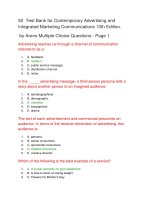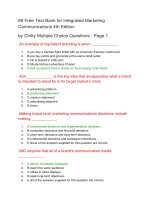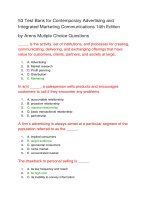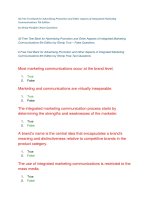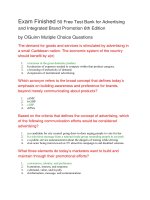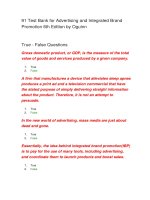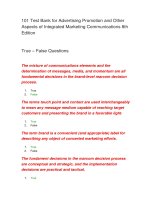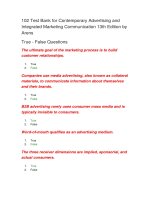Contemporary advertising and integrated marketing communications 14th edition arens test bank
Bạn đang xem bản rút gọn của tài liệu. Xem và tải ngay bản đầy đủ của tài liệu tại đây (485.69 KB, 105 trang )
Chapter 02
The Big Picture: The Evolution of IMC
True / False Questions
1.
Economics has created the need for advertising and has made it a staple of the free enterprise
system.
True
2.
False
A market economy is characterized by two assumptions: the interest of the community and the
presence of externalities.
True
3.
False
Open competition between self-interested sellers advertising to self-interested buyers leads to
greater product availability at more competitive prices.
True
4.
False
The sale or consumption of products rarely benefits or harms other people who are not involved in
the transaction and who did not pay for the product.
True
False
2-1
© 2013 by McGraw-Hill Education. This is proprietary material solely for authorized instructor use. Not authorized for sale or distribution in
any manner. This document may not be copied, scanned, duplicated, forwarded, distributed, or posted on a website, in whole or part.
5.
The assumptions characterizing a market economy describe an ideal economy, not one that
actually exists.
True
6.
The most significant function of advertising is to lower the overall cost of sales.
True
7.
False
False
In a free-market economy, when one company starts making significant profits, other companies
immediately jump in to compete.
True
8.
Messages aimed to encourage trade were unheard of in pre-industrial societies.
True
9.
False
False
Benjamin Franklin was the first American known to use illustrations in ads.
True
False
10. The emergence of urban markets following the Industrial Revolution hindered the growth of
advertising.
True
False
11. The advertising industry existed before the industrial age.
True
False
2-2
© 2013 by McGraw-Hill Education. This is proprietary material solely for authorized instructor use. Not authorized for sale or distribution in
any manner. This document may not be copied, scanned, duplicated, forwarded, distributed, or posted on a website, in whole or part.
12. The American profession of advertising began when Volney B. Palmer set up business in
Philadelphia in 1841.
True
False
13. A. C. Nielsen produced the earliest catalogs, bringing a wide variety of products to new, rural
markets.
True
False
14. A vodka company using the slogan "Spirit for the Spirited" in order to enhance the appeal of its
brand is using product differentiation.
True
False
15. A product's unique selling point is a feature that differentiates it from competitive products.
True
False
16. Market segmentation is a process by which manufacturers seek to portray their brands as different
from and better than the competition by offering consumers quality, variety, and convenience.
True
False
17. Demarketing is used by marketers primarily to identify unique groups of people whose needs can
be addressed through more specialized products.
True
False
2-3
© 2013 by McGraw-Hill Education. This is proprietary material solely for authorized instructor use. Not authorized for sale or distribution in
any manner. This document may not be copied, scanned, duplicated, forwarded, distributed, or posted on a website, in whole or part.
18. A megamerger occurs when big multinational companies buy other big companies in order to
expand globally.
True
False
19. Beginning around 1980, the postindustrial age has been a period of relative stability.
True
False
20. The marketing world of the postindustrial age was characterized by competition intensified by
lower trade barriers and growing international trade.
True
False
21. Larry Page and Sergey Brin developed AdWords, an advertising program, that eventually generated
billions in profits.
True
False
22. The importance of advertising in individual countries depends on the country’s level of
development and national attitude toward promotion.
True
False
23. Small companies and product marketers that appeal to a limited clientele use TV to reach
audiences with unique interests.
True
False
2-4
© 2013 by McGraw-Hill Education. This is proprietary material solely for authorized instructor use. Not authorized for sale or distribution in
any manner. This document may not be copied, scanned, duplicated, forwarded, distributed, or posted on a website, in whole or part.
24. Advertising has been a major factor in improving the standard of living in the United States and
around the world.
True
False
25. Advertising helps create personalities for products in the market.
True
False
Multiple Choice Questions
26. Which of the following is an assumption that characterizes a free-market economy?
A. Presence of externalities
B. Few buyers and sellers
C. Self-interest
D. Greater involvement of the government
E. Emphasis on communal goals
27. Which of the following is true of a market economy?
A. The government determines what and how much is produced and consumed.
B. Firms and households rarely interact in the marketplace.
C. Open competition between self-interested sellers advertising to self-interested buyers adversely
affects product availability.
D. The role of information is negligible with regard to buying decisions.
E. People and firms pursue their own goals.
2-5
© 2013 by McGraw-Hill Education. This is proprietary material solely for authorized instructor use. Not authorized for sale or distribution in
any manner. This document may not be copied, scanned, duplicated, forwarded, distributed, or posted on a website, in whole or part.
28. Which of the following refers to an externality associated with the purchase of firearms?
A. An increase in the rate of crime
B. An increase in the popularity of shooting sports
C. Easy availability of cheap, after-sales service of firearms
D. Enhanced personal security
E. An increase in exports of firearms
29. Which of the following functions does advertising serve as a marketing tool?
A. Withhold information about products and the place of sale
B. Discourage reuse of products
C. Increase the overall cost of sales
D. Increase the use of products
E. Create and sustain market monopolies
30. Which of the following is a basic function of branding?
A. To ensure that all products are offered at everyday low prices
B. To identify products and differentiate them from others
C. To dampen the demand for unwanted products
D. To search for unique groups of people with special product needs
E. To impede the distribution of products
2-6
© 2013 by McGraw-Hill Education. This is proprietary material solely for authorized instructor use. Not authorized for sale or distribution in
any manner. This document may not be copied, scanned, duplicated, forwarded, distributed, or posted on a website, in whole or part.
31. Which of the following is a benefit provided to a company by strong brands?
A. They tend to trigger price wars.
B. They eliminate the chance of failure for new products completely.
C. They garner consumer loyalty.
D. They encourage customers to choose products from different companies.
E. They ensure uniform pricing versus competitors.
32. During the _____, the Chinese invented paper and Gutenberg invented the printing press in
Germany.
A. preindustrial age
B. Industrial Revolution
C. information revolution
D. industrial age
E. postindustrial age
33. Until the advent of public schooling in America, many advertisements took the form of signs with
symbols, such as a beer tankard indicating a tavern, because:
A. most people were illiterate and could not read.
B. the advertisers could not afford to produce sophisticated advertisements.
C. there were laws prohibiting advertising in newspapers and handbills.
D. the Church would not approve of any other form of advertising.
E. such advertisements promoted puffery.
2-7
© 2013 by McGraw-Hill Education. This is proprietary material solely for authorized instructor use. Not authorized for sale or distribution in
any manner. This document may not be copied, scanned, duplicated, forwarded, distributed, or posted on a website, in whole or part.
34. Which famous English literary figure's observation that advertisements were so numerous that they
were “negligently perused” and that it had become necessary to gain attention “by magnificence of
promise”, led to the beginning of puffery in advertising?
A. Samuel Pepys
B. Nicholas Rowe
C. William Congreve
D. John Dennis
E. Samuel Johnson
35. Which of the following products was advertised in the first ad in English that appeared in 1472?
A. A plow
B. A farm animal
C. A prayer book
D. A religious service
E. A country tavern
36. In the context of early advertising, the invention of the _____ made advertising via posters, handbills,
and signs possible.
A. quill pen
B. printing press
C. silk screen
D. lead molding machine
E. steam engine
2-8
© 2013 by McGraw-Hill Education. This is proprietary material solely for authorized instructor use. Not authorized for sale or distribution in
any manner. This document may not be copied, scanned, duplicated, forwarded, distributed, or posted on a website, in whole or part.
37. In the industrial age, fresh mass markets developed for new and inexpensive brands of luxury and
convenience goods called _____.
A. pure public goods
B. business goods
C. consumer packaged goods
D. intermediate goods
E. common goods
38. Who among the following is regarded as the father of advertising art and was the first American
known to use illustrations in ads?
A. Benjamin Franklin
B. Johannes Gutenberg
C. Samuel Johnson
D. Samuel Pepys
E. Marcel Bleustein-Blanchet
39. An ad in a fitness magazine offered a 30-day, free, at-home trial of an exercise bicycle with free
shipping, and the option of returning the bicycle if the customer was not satisfied with it. The
primary function of the ad was to:
A. control competitive pricing practices.
B. establish exclusive distribution rights for the bicycle.
C. communicate the company's quality mission.
D. induce consumers to try the bicycle.
E. communicate information about the bicycle's after-sale service.
2-9
© 2013 by McGraw-Hill Education. This is proprietary material solely for authorized instructor use. Not authorized for sale or distribution in
any manner. This document may not be copied, scanned, duplicated, forwarded, distributed, or posted on a website, in whole or part.
40. The industrial age started during:
A. the second half of the 16th century.
B. the second half of the 15th century.
C. the second half of the 19th century.
D. the second half of the 20th century.
E. the second half of the 17th century.
41. Which of the following statements most accurately describes the role of manufacturers during the
1800s?
A. Manufacturers were responsible for marketing their products.
B. Manufacturers stimulated consumer demand through mass media advertising.
C. Manufacturers were primarily responsible for keeping retailers informed about the sources of
supply and shipping schedules for commodities.
D. Manufacturers were principally concerned with production.
E. Manufacturers were principally concerned with segmenting markets for their products.
42. During the 1800s, wholesalers placed ads in publications called _____ that informed retailers about
the sources of supply and shipping schedules for commodities.
A. supply currents
B. demand currents
C. price currents
D. puff pieces
E. sales pitches
2-10
© 2013 by McGraw-Hill Education. This is proprietary material solely for authorized instructor use. Not authorized for sale or distribution in
any manner. This document may not be copied, scanned, duplicated, forwarded, distributed, or posted on a website, in whole or part.
43. Which American hired the first full-time agency copywriter in the industrial age?
A. Claude Hopkins
B. Francis Ayer
C. A.C. Nielsen
D. Albert Lasker
E. Volney B. Palmer
44. During the Great Depression in America, each brand sought to convince the public of its own
special qualities. What is this marketing strategy known as?
A. Production focus
B. Demarketing
C. Product differentiation
D. Puffery
E. Market segmentation
45. Which of the following historical events in the first half of the 20th century caused advertising
expenditures to plummet in America?
A. Germany's defeat in World War I
B. The Fairbanks Gold Rush
C. The stock market crash on October 29, 1929
D. The Bolshevik Revolution
E. The introduction of a new system of consumer credit
2-11
© 2013 by McGraw-Hill Education. This is proprietary material solely for authorized instructor use. Not authorized for sale or distribution in
any manner. This document may not be copied, scanned, duplicated, forwarded, distributed, or posted on a website, in whole or part.
46. Scientific Advertising, the bible of the era of salesmanship in the 1920s, was written by _____.
A. Johannes Gutenberg
B. Benjamin Franklin
C. Claude Hopkins
D. Volney B. Palmer
E. Francis Ayer
47. During the 19th century, manufacturers changed their focus to _____ in order to wrest back control
from wholesalers.
A. production orientation
B. marketing orientation
C. labor orientation
D. cost orientation
E. process orientation
48. Which of the following is an example of product differentiation?
A. A marketer searching for unique groups of people whose needs could be addressed through
more specialized products
B. Manufacturers of electric heating appliances using advertising to slow the demand for their
products
C. Marketers engaged in manipulating the supply of consumer goods to create artificial demand
D. An automobile manufacturer trying to lower the cost of production by manufacturing a small
number of cars during lean periods
E. A manufacturer of cosmetics trying to portray that its brands are not only different from its
competitors but also superior in terms of quality and variety
2-12
© 2013 by McGraw-Hill Education. This is proprietary material solely for authorized instructor use. Not authorized for sale or distribution in
any manner. This document may not be copied, scanned, duplicated, forwarded, distributed, or posted on a website, in whole or part.
49. The American profession of advertising began when _____ set up business in Philadelphia in 1841.
A. Claude Hopkins
B. Volney B. Palmer
C. Benjamin Franklin
D. Samuel Johnson
E. Francis Ayer
50. Which of the following can be attributed to the ad agency, N. W. Ayer & Sons, set up by Francis
Ayer in 1869?
A. It pioneered the use illustrations in ads.
B. It introduced the use of large headlines and considerable white space in ads.
C. It was the first ad agency to charge a commission based on the "net cost of space."
D. It introduced full color printings in magazines.
E. It published the first printed ad in English.
51. Who among the following introduced the idea that every ad must point out the product’s USP?
A. Rosser Reeves
B. Leo Burnett
C. David Ogilvy
D. Bill Bernbach
E. Claude Hopkins
2-13
© 2013 by McGraw-Hill Education. This is proprietary material solely for authorized instructor use. Not authorized for sale or distribution in
any manner. This document may not be copied, scanned, duplicated, forwarded, distributed, or posted on a website, in whole or part.
52. A feature that differentiates a coffee-maker from other similar products in the market is its _____.
A. trademark
B. share of wallet
C. Q score
D. brand value
E. unique selling proposition
53. _____ refers to a process by which marketers search for unique groups of people whose needs can
be addressed through more specialized products.
A. Relationship marketing
B. Demarketing
C. Action advertising
D. Branding
E. Market segmentation
54. Which of the following strategies best describes a company's efforts to slow the demand for
cigarettes through public service messages?
A. Macromarketing
B. Product positioning
C. Corrective advertising
D. Demarketing
E. Image advertising
2-14
© 2013 by McGraw-Hill Education. This is proprietary material solely for authorized instructor use. Not authorized for sale or distribution in
any manner. This document may not be copied, scanned, duplicated, forwarded, distributed, or posted on a website, in whole or part.
55. A publishing company prints three monthly magazines—one each for horse breeders, adventure
sports enthusiasts, and care givers—to cater to different groups of readers with varying interests.
This is an instance of _____.
A. multi-level marketing
B. market segmentation
C. product differentiation
D. unique selling proposition
E. production focus
56. Which of the following is the primary objective of demarketing?
A. To separate a particular brand from its competitors by associating that brand with a particular set
of customer needs that ranked high on the consumer’s priority list
B. To cater to unique groups of people whose needs could be addressed through more specialized
products
C. To stimulate demand for a product artificially by manipulating supply
D. To dampen demand for products, especially those that create unwanted costs for society
E. To encourage consumers to reuse products
2-15
© 2013 by McGraw-Hill Education. This is proprietary material solely for authorized instructor use. Not authorized for sale or distribution in
any manner. This document may not be copied, scanned, duplicated, forwarded, distributed, or posted on a website, in whole or part.
57. In the context of advertising, market segmentation is the process of:
A. portraying one's brands as different and better than competitors by offering quality, variety, and
convenience.
B. increasing profitability through a greater sales volume obtained from new products.
C. depressing the demand for products that create unwanted costs for the society.
D. searching for unique groups of people whose needs could be addressed through more
specialized products.
E. stimulating demand artificially by manipulating the supply chain
58. A product's unique selling proposition refers to:
A. the brand loyalty it enjoys.
B. a feature that differentiates it from competitive products.
C. the unique pricing strategy used to determine the market price of the product.
D. the degree of consumer commitment toward the product and its brand.
E. the rate of usage of the product.
59. _____ is an effective way to separate a particular brand from its competitors by associating that
brand with a particular set of customer needs that rank high on the consumer's priority list.
A. Visual merchandising
B. Mobile marketing
C. Positioning strategy
D. Market aggregation strategy
E. Demarketing
2-16
© 2013 by McGraw-Hill Education. This is proprietary material solely for authorized instructor use. Not authorized for sale or distribution in
any manner. This document may not be copied, scanned, duplicated, forwarded, distributed, or posted on a website, in whole or part.
60. When a soft drink company introduced a new peach-flavored drink in a market saturated with
colas, it immediately found favor with health-conscious consumers. In this example, the soft drink
company effectively uses _____ by associating its brand with the consumers' focus on healthy living.
A. demarketing
B. relationship marketing
C. positioning strategy
D. direct marketing
E. mobile marketing
61. Gold Sheen, a cosmetic company, introduced a new range of herbal cosmetics in a market largely
dominated by non-herbal products. Aware of the growing customer concern surrounding the
overuse of chemicals in beauty products, Gold Sheen's strategy was to associate its brand with
long-term safety that ranked high on consumers' priority list. Which of the following strategies does
Gold Sheen use in this instance?
A. Vertical integration strategy
B. Diversification strategy
C. Positioning strategy
D. Horizontal integration strategy
E. Product placement strategy
2-17
© 2013 by McGraw-Hill Education. This is proprietary material solely for authorized instructor use. Not authorized for sale or distribution in
any manner. This document may not be copied, scanned, duplicated, forwarded, distributed, or posted on a website, in whole or part.
62. Which of the following is true of the postindustrial age?
A. The postindustrial age was a period of relative stability.
B. Ads asked people to use electrical appliances mostly during the day.
C. Producers of energy and energy-consuming goods used advertising to slow the demand for
their products.
D. The production of energy peaked during 1970s and 1980s.
E. Demarketing lost favor as a marketing tool.
63. Canada is a popular tourist destination. Many tourists visit the country because of its scenic beauty.
This spate of visitors every year has led to the possibility of ecological disasters in the area. In
response, government officials and environment protection groups are currently trying to check the
number of tourists visiting the country. They could use a(n) _____ strategy to accomplish this
objective.
A. diversification
B. eco marketing
C. market segmentation
D. demarketing
E. relationship marketing
2-18
© 2013 by McGraw-Hill Education. This is proprietary material solely for authorized instructor use. Not authorized for sale or distribution in
any manner. This document may not be copied, scanned, duplicated, forwarded, distributed, or posted on a website, in whole or part.
64. An ad for a beer company that asks consumers to enjoy beer in moderation and not drink
irresponsibly is most likely using _____.
A. conservation marketing
B. demarketing
C. trade advertising
D. green marketing
E. relationship marketing
65. After the end of the Cold War, big multinational companies and their advertising agencies went on
a binge, buying other big companies. Which of the following terms describes this occurence?
A. Divestment
B. Vertical integration
C. Horizontal integration
D. Megamerger
E. Acquisition
66. Two related economic factors characterized the marketing world of the 1980s in the United States.
One of those factors was:
A. an aging higher management, which led to a lack of innovation.
B. the growing burden of financial debt, forcing governments to return to aggressive high tax
policies.
C. the implementation of affirmative action policies.
D. the aging of traditional products, with a corresponding growth in competition.
E. the rise of trade barriers such as import tariffs.
2-19
© 2013 by McGraw-Hill Education. This is proprietary material solely for authorized instructor use. Not authorized for sale or distribution in
any manner. This document may not be copied, scanned, duplicated, forwarded, distributed, or posted on a website, in whole or part.
67. During the postindustrial age, a growing affluence and sophistication of the consuming public
characterized the marketing world of that time period in America. This trend was led by the _____.
A. baby boomer generation
B. Generation X
C. Generation Y
D. immigrants from Latin America
E. millenials
68. Which of the following characterizes the marketing world of the postindustrial age?
A. Higher trade barriers
B. Intense competition and growing international trade
C. The decline of European ad agencies
D. An increased demand for traditional products
E. Less choices for consumers
69. _____ created a social media company called Facebook.
A. Larry Page
B. Mark Zuckerberg
C. Charles Saatchi
D. Tom Cuniff
E. Sergey Brin
2-20
© 2013 by McGraw-Hill Education. This is proprietary material solely for authorized instructor use. Not authorized for sale or distribution in
any manner. This document may not be copied, scanned, duplicated, forwarded, distributed, or posted on a website, in whole or part.
70. Who among the following developed AdWords, an advertising program for Google?
A. Saatchi and Saatchi
B. Page and Brin
C. Bates and Fitzgerald
D. Zuckerberg and Sample
E. Lasker and Hopkins
71. Which of the following statements is true of the traditional advertising industry in America in the
beginning of the 1990s?
A. The traditional advertising industry suffered from overpopulation.
B. Clients were satisfied with the results from their promotional dollars.
C. The traditional advertising industry found it easiest to reach affluent consumers.
D. The traditional advertising industry was deregulated, which led to international growth.
E. The traditional advertising industry faced the greatest level of prosperity in its history during the
postindustrial age.
72. The record decline in advertising activity in America in 2001 resulted from:
A. the lack of creative thinking in advertising.
B. the declining popularity of television as a medium for the mass market.
C. a mild recession, a weak stock market, and the burst of the dot-com.
D. rapid deregulation.
E. the increasing use of the Internet as an advertising medium.
2-21
© 2013 by McGraw-Hill Education. This is proprietary material solely for authorized instructor use. Not authorized for sale or distribution in
any manner. This document may not be copied, scanned, duplicated, forwarded, distributed, or posted on a website, in whole or part.
73. Typically, advertising expenditures are higher in countries with higher _____.
A. budget deficits
B. personal incomes
C. commodity prices
D. media regulations
E. inflation rates
74. In the context of advertising, which of the following refers to a major feature of TiVo?
A. The ability to target potential customers and measure effectiveness against that target
B. The ability to identify products and their source and to differentiate them from others
C. The ability to help companies recruit top talent
D. The ability to lower the overall cost of sales
E. The ability to afford protection against price wars
75. Which of the following significantly contributed and eventually led to the declines in music sales in
the recording industry in the postindustrial age?
A. The rising popularity of TV
B. Increased use of remote controls
C. File-sharing technologies
D. Poor relationship marketing
E. Channel-surfing habits of TV audiences
2-22
© 2013 by McGraw-Hill Education. This is proprietary material solely for authorized instructor use. Not authorized for sale or distribution in
any manner. This document may not be copied, scanned, duplicated, forwarded, distributed, or posted on a website, in whole or part.
76. Which of the following has become the new marketing imperative for the 21 st century?
A. Diversification
B. Divestment
C. Customer relationship
D. Direct selling
E. Demarketing
77. In keeping with its commitment to green technology, a reputed automobile company introduced a
line of luxury hybrid cars in the market. By being consistent in both what it says and does, this
company is engaged in _____.
A. transactional marketing
B. direct-response marketing
C. relationship marketing
D. promotional marketing
E. social media marketing
78. By publicizing the material, social, and cultural opportunities of a free enterprise society, advertising
in the United States has:
A. encouraged increased productivity.
B. encouraged demarketing.
C. discouraged relationship marketing.
D. discouraged reuse of products.
E. encouraged divestment.
2-23
© 2013 by McGraw-Hill Education. This is proprietary material solely for authorized instructor use. Not authorized for sale or distribution in
any manner. This document may not be copied, scanned, duplicated, forwarded, distributed, or posted on a website, in whole or part.
79. Which of the following is true about the impact of advertising on the society and the economy?
A. Advertising has been a major factor in eliminating price wars between global brands.
B. Advertising has been a major factor in eliminating economic inequities in the society.
C. Advertising has been a major factor in establishing cultural diversity.
D. Advertising has been a major factor in improving the standard of living in the United States and
around the world.
E. Advertising has been a major factor in creating and sustaining trade monopolies in the United
States and around the world.
80. In the 1970s, a new American consumer movement grew out of the widespread disillusionment
following:
A. the Great Depression.
B. the Civil Rights Movement.
C. the Cold War.
D. the fall of the Berlin Wall.
E. the Vietnam War.
Short Answer Questions
2-24
© 2013 by McGraw-Hill Education. This is proprietary material solely for authorized instructor use. Not authorized for sale or distribution in
any manner. This document may not be copied, scanned, duplicated, forwarded, distributed, or posted on a website, in whole or part.
81. What is the significance of information in the context of a market economy?
82. Which is the first U.S. publication for ad profession?
83. Name the first "typefounder" who perfected a roman typeface that bears his name and is still used
today.
2-25
© 2013 by McGraw-Hill Education. This is proprietary material solely for authorized instructor use. Not authorized for sale or distribution in
any manner. This document may not be copied, scanned, duplicated, forwarded, distributed, or posted on a website, in whole or part.
